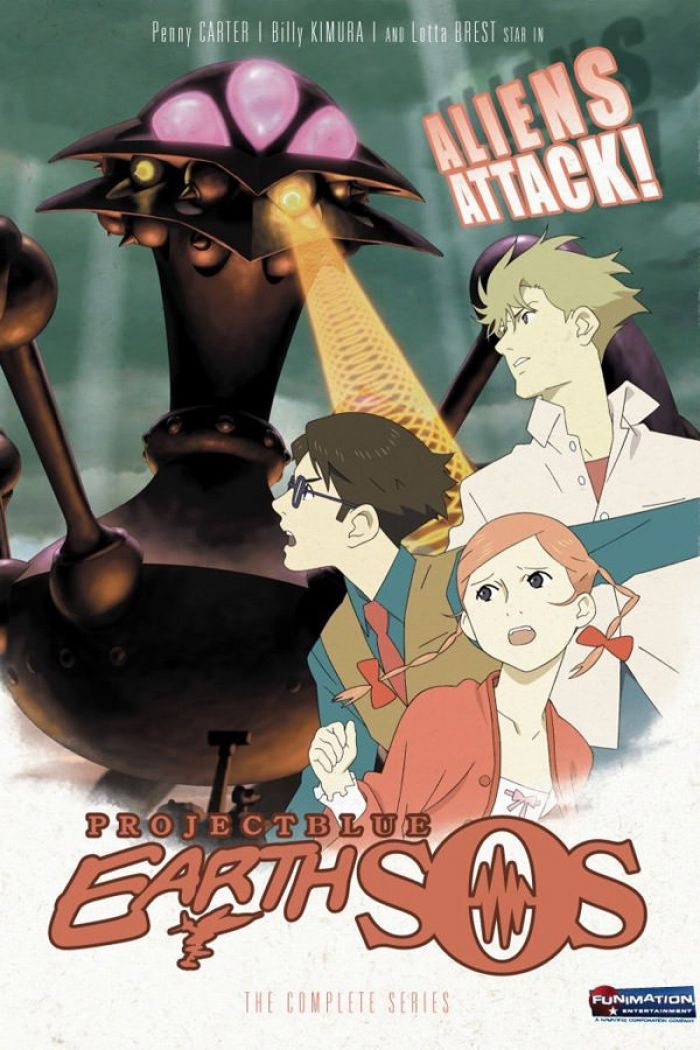Project Blue Earth SOS by Tensai Okamura (Review)

It’s pretty easy to break Project Blue Earth SOS down into its individual similarities and influences, were one so inclined. On paper, the series blends together themes, ideas, and visuals from Plan 9 From Outer Space, Independence Day, Star Wars, War of the Worlds (moreso the 1953 Byron Haskin film then other versions), The Hardy Boys, Sky Captain and the World of Tomorrow, and even other anime titles like Neon Genesis Evangelion and Giant Robo. But the series is easily far more than the sum of its parts, a rollicking retro-futuristic tale of alien invaders, boy geniuses, and cool gizmos that revels in its vintage style and flair.
It’s the year 2000, and most of human technology relies on “G-Reaction” engines, which are used in trains, airliners, and even submarines. However, when “G-Reaction” vehicles begin to mysteriously disappear all over the planet, everyone is stumped. Everyone, it seems, except two boy geniuses named Billy Kimura and Penny Carter. Initially at odds — Kimura is the wealthy heir to a massive corporate empire, Carter an orphan who has put himself through school — the two reluctantly join forces after encountering a mysterious apparition who cryptically announces an impending apocalypse.
The apocalypse is soon revealed to be a massive invasion by an alien race called the Baguan whose technology far exceeds that of humanity (natch). Humanity has one final refuge: Metropolitan X, a massive underwater city/military base designed by the Labyrinth Alliance, a secretive organization of scientists that has been preparing its own advanced technology in case of just such an event. But will it be enough to rescue humanity from certain doom? Why, exactly, are the Baguan attacking Earth? And just how does a couple of teens out-think Earth’s best minds so easily?
Project Blue Earth SOS is a lot of fun, so long as you’re willing to just go along for the ride and buy into its style and tone. I was particularly hooked by the series’ retro-futuristic style. Imagine the optimistic vision of the future that you see illustrated on Popular Mechanics covers from the 1940s and 1950s, and you’ll get the basic idea. Jet packs, ray guns, hovercars (with big pink tailfins, natch), zeppelin-like spacecraft, a jet fighter that looks like a souped up F-104… the series has all of these wonderful gizmos, and more. Throw in the aforementioned boy geniuses capable of out-thinking and out-inventing the world’s greatest scientists on a regular basis, shadowy scientific cabals, and femme fatales, and Project Blue Earth SOS really hits a sweet spot for me — even when the plot drags or the character arcs fall flat.
However, while it’s a lot of fun to watch, Project Blue Earth SOS is a bit more than some mere juvenile wish fulfillment about saving the world with really neat gadgets. For one thing, the series has a surprising amount of pathos and grim-ness. Certainly, the apocalyptic setting helps, as do the various cliffhangers that our heroes find themselves in. Director Tensai Okamura (Darker Than Black, Wolf’s Rain) and writer Ryota Yamaguchi (Cowboy Bebop, Escaflowne: The Movie) love ratcheting up the odds and putting their characters through the wringer, especially Penny Carter, who is forced to deal with his tragic past in some disturbing ways. (To the series’ credit, it delves into disturbing territory without ever feeling exploitative, or detracting too much from its infectious spirit. In fact, it’s actually a bit easier to buy into its overall optimistic tone because of the gloom.)
And while the series’ characters are constantly singing the praises of science as the only way to defeat the Baguan and ensure humanity’s survival — it’s not uncommon for a character to shout something like “Believe in it, the power of human science!” as a quasi-warcry — the series could also be seen as a cautionary tale of sorts about the dangers of succumbing to scientific arrogance and playing God. This can be seen in those moments when Kimura or Carter’s latest gizmo or “foolproof” plan blows up in their face, but it becomes especially apparent in the series’ final episode, when the truth about the Baguans and their invasion is revealed. Admittedly, the series doesn’t spend too much time on that particular theme — understandable, since doing so would distract from the whiz-bang gadgets and derring-do — but it adds some welcome depth and thoughtfulness to the highly stylized proceedings.
Project Blue Earth SOS is not without its flaws, though. I found myself rolling my eyes at the umpteenth time Kimura and Carter were able come up with just the right plan or device at just the right time to rescue humanity from the brink of extinction. Nearly all of the characters could’ve been fleshed out more, and one character probably could’ve been removed altogether (her primary contribution to humanity’s efforts seems to be fainting at the slightest hint of danger). And for all of their advanced technological knowhow, the alien invaders’ nefarious plans do occasionally hinge on silliness.
Those are small criticisms, however, compared to the simple, escapist, and fantastical fun that Project Blue Earth SOS offers. Early on, the series’ announcer proclaims Project Blue Earth SOS to be an “extra-special grandiose sci-fi adventure.” As the series unfolds, and our heroes save damsels in distress from brainwashed alien thugs, steal a flying saucer from the invaders’ secret island fortress, or combat the Baguans’ weather control device with a rocket-powered drill vehicle that would make International Rescue green with envy, you realize that’s as accurate a description as any.